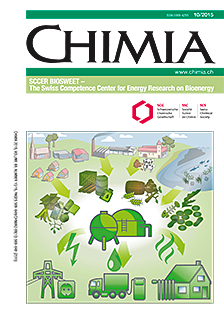Biochemical Conversion Processes of Lignocellulosic Biomass to Fuels and Chemicals – A Review
DOI:
https://doi.org/10.2533/chimia.2015.572Keywords:
Biorefinery, Cellulase, Consolidated bioprocessing (cbp), Sugar platform, Synthetic microbial consortiumAbstract
Lignocellulosic biomass – such as wood, agricultural residues or dedicated energy crops – is a promising renewable feedstock for production of fuels and chemicals that is available at large scale at low cost without direct competition for food usage. Its biochemical conversion in a sugar platform biorefinery includes three main unit operations that are illustrated in this review: the physico-chemical pretreatment of the biomass, the enzymatic hydrolysis of the carbohydrates to a fermentable sugar stream by cellulases and finally the fermentation of the sugars by suitable microorganisms to the target molecules. Special emphasis in this review is put on the technology, commercial status and future prospects of the production of second-generation fuel ethanol, as this process has received most research and development efforts so far. Despite significant advances, high enzyme costs are still a hurdle for large scale competitive lignocellulosic ethanol production. This could be overcome by a strategy termed 'consolidated bioprocessing' (CBP), where enzyme production, enzymatic hydrolysis and fermentation is integrated in one step – either by utilizing one genetically engineered superior microorganism or by creating an artificial co-culture. Insight is provided on both CBP strategies for the production of ethanol as well as of advanced fuels and commodity chemicals.Downloads
Published
2015-10-28
How to Cite
[1]
S. Brethauer, M. H. Studer, Chimia 2015, 69, 572, DOI: 10.2533/chimia.2015.572.
Issue
Section
Scientific Articles
License
Copyright (c) 2015 Swiss Chemical Society

This work is licensed under a Creative Commons Attribution-NonCommercial 4.0 International License.







